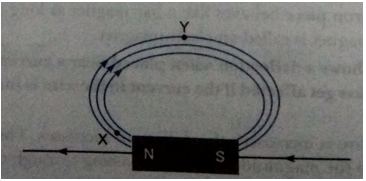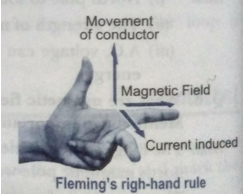Short Answer Questions - II - 3 Marks
Que 1. Magnetic field lines are shown in the given diagram. A student makes a statement that magnetic field at X is stronger than at Y. Justify this statement. Also redraw the diagram and mark the direction of magnetic field lines.

Ans. The relative strength of the magnetic field is shown by the degree of closeness of the field lines. The degree of closeness is more at X than at Y. Therefore, the field is stronger at X where the field lines are crowded.

Que 2. What is the difference between a direct current and an alternating current? How many times does AC used in India change direction in one second?
Ans. Direct current always flows in one direction but the alternating current reverses its direction periodically. Also the magnitude of current in case of DC is same throughout whereas in case of AC, it changes continuously. The frequency of AC in India is 50 Hz and in each cycle it alters direction twice. Therefore, AC changes direction 2 x 50 = 100 times in one second.
Que 3. How can the magnitude of the induced current be increased?
Ans. The magnitude of the induced current can be increased by:
(i) Taking the conductor in the form of a coil of many turns of insulated wire.
(ii) Increasing the strength of the magnetic field used.
(iii) Increasing the rate of change of magnetic flux associated with the coil.
Que 4. What is the role of fuse used in series with any electrical appliance? Why should a fuse with defined rating not be replaced by one with a larger rating?
Ans. Fuse is used for protecting appliances due to short-circuiting or overloading. The fuse is rated for a certain maximum current and blows off when a current more than the rated value flows through it. If a fuse is replaced by one with larger ratings, the appliances may get damaged while the protecting fuse does not burn off. This practice of using fuse of improper rating should always be avoided.
Que 5. Answer the following questions:
(i) What is the direction of magnetic field lines outside a bar-magnet?
(ii) The magnetic field lines in a given region are getting crowded. What does it indicate?
(iii) State one advantage of AC over DC.
Ans. (i) North pole to south pole.
(ii) The strength of magnetic field is higher in this region.
(iii) A.C. voltage can be stepped up and transmitted over long distances without much loss of energy.
Que 6. What are magnetic field lines? How is the direction of a magnetic field at a point determined? Mention two important properties of magnetic field lines.
Ans. The magnetic field lines of force are the lines drawn in a magnetic field along which a hypothetical north magnetic pole would move if it is free to do so.
The direction of a magnetic field at a point is the direction of the resultant force acting on a hypothetical north pole placed at that point. The tangent at any point on the magnetic field line gives the direction of magnetic field at that point. The direction of the magnetic field at a point can be found by placing a small magnetic compass at that point. The north end of the needle indicates the direction of the field.
Two important properties of the magnetic lines of force are:
(i) The magnetic lines of force start from north pole and terminate at south pole. Inside the magnet they travel from south pole to north pole. Thus, they are closed curves.
(ii) They do not intersect each other because at the point of intersection there will be two directions of same magnetic field which is impossible.
Que 7. A copper coil is connected to a galvanometer. What would happen if a bar magnet is
(i) pushed into the coil with its north pole entering first
(ii) held at rest inside the coil
(iii) pulled out again?
Ans. (i) When north pole is pushed into the coil, a momentary deflection is observed in the galvanometer. This deflection indicates that a momentary current is produced in the coil. The direction of current in the coil is anticlockwise.
(ii) When the magnet is held at rest, there is no deflection in the galvanometer. It indicates that no current is produced in the coil in this use.
(iii) In pulling the magnet out of the coil, a deflection in opposite direction is observed. It indicates that the current produced in the coil is in opposite direction.
Que 8. Explain what is short circuiting and overloading in an electric supply.
Ans. Short circuiting: Whenever live and neutral wires come in contact with each other, the incident is called short circuiting. In this case, resistance of a circuit decreases to a very small value. The decreasing of resistance increases the current. Due to this increased current, the wires get heated. This extreme heat may cause fire in the building.
Overloading: Every supply has a capacity to bear a maximum load, i.e., the power that can be supplied has a limit. Sometimes, the number of appliances which are switched on at the same time have power more than the capacity of the line. This is called overloading. In this situation, wires of the supply get heated due to extremely large current flowing through them and the circuit may catch fire. To avoid this fire, we use an electric fuse in the circuit.
Que 9. What change in the deflection of the compass needle placed at a point near current carrying straight conductor shall be observed if the (a) current through the conductor is increased? (b) direction of current in the conductor is reversed? (c) compass is moved away from the conductor?
Ans. (a) Deflection increases.
(b) Direction of deflection is reversed.
(c) Deflection decreases.
Que 10. Name and state the rule used for determination of direction of induced current produced in a conductor due to a changing magnetic field and give one practical application of this phenomenon in everyday life.
Ans. Rule: Fleming's right-hand rule.

It states that if we stretch the thumb, forefinger and middle finger of our right hand such that they are mutually perpendicular to each other. If forefinger indicates direction of magnetic field and the thumb shows the direction of motion of conductor, then middle finger will show direction of induced current.
Application: Electrical generator.
Que 11. A coil made of insulated copper wire is connected to a galvanometer. What will happen to the deflection of the galvanometer if this coil is moved towards a stationary bar magnet and then moved away from it? Give reason for your answer and name the phenomenon involved.
Ans. When coil is moved towards a stationary magnet, the magnetic field associated with the coil will change and so current will be induced in the coil. This causes galvanometer to show deflection in one direction. Now when coil is moved away, the magnetic field will decrease and so current induces in the opposite direction causing galvanometer to show deflection in opposite direction. The phenomenon is electromagnetic induction.
Que 12. In what respect does the construction of an AC generator differ from that of a DC generator?
Ans. The only difference between a DC generator and an AC generator is in the way the two ends of the generator coil are connected to the outer circuit. In a DC generator, the two ends of the generator coil are connected to a split ring type commutator consisting of two half rings of copper. In an AC generator, the ends of the coil are connected to two full rings of copper called slip rings. There is no commutator in an AC generator.

